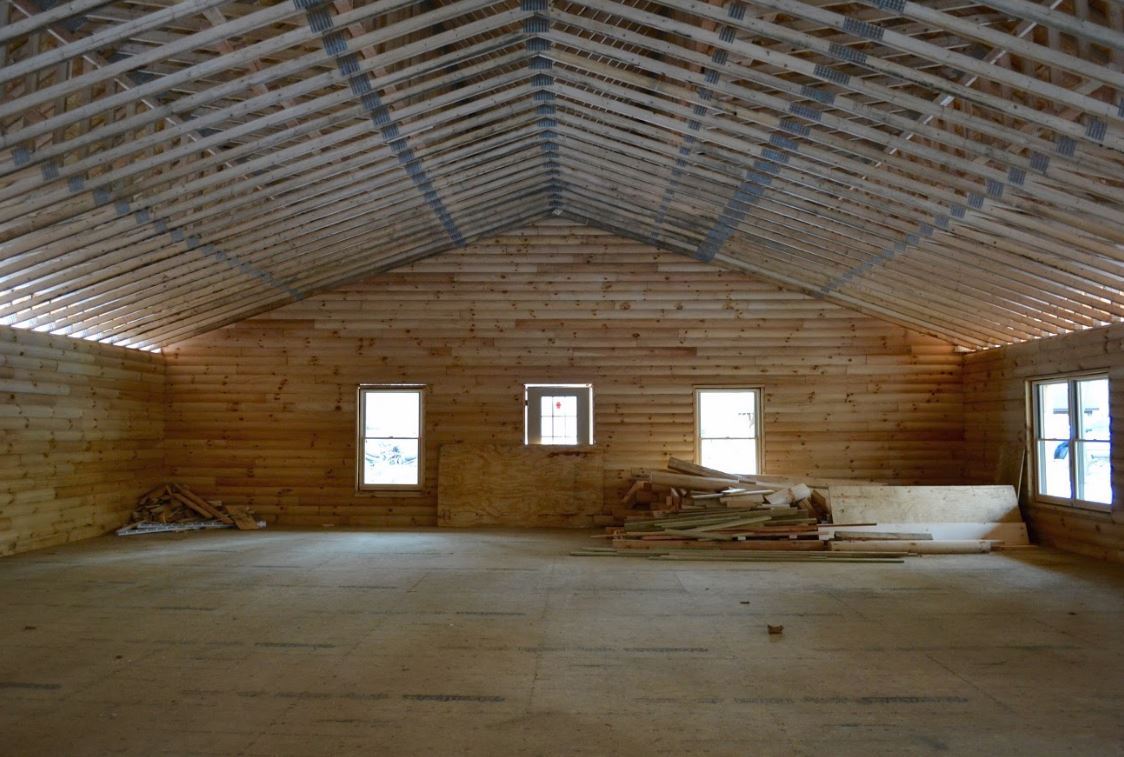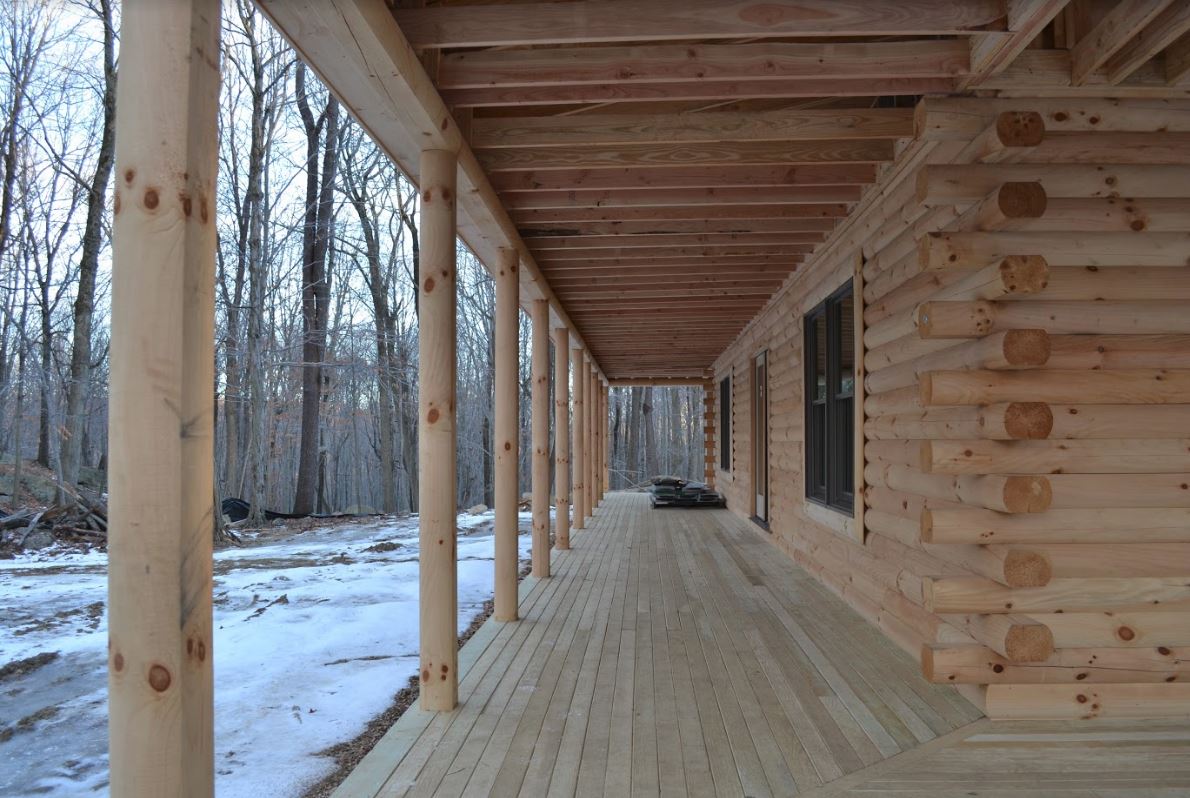Log Cabin Unveiled at Sturges Park
HamletHub Written by Amber Bodeur
See full article here
Tucked away at the end of a cul-de-sac on Rippowam Road is Sturges Park. Rich in history, the original “Girl Scout Camp Catoonah” (circa 1950) was sold by the Girl Scouts nearly two decades ago and, thanks to community-minded Ridgefielders, preserved from development and donated to the Town of Ridgefield.
“The origins of the property were donations from two long time Ridgefield families. One of those families, the Sturges Family, had put a deed restriction on their land donation,” explains Phil Kearns, Chairman of the Ridgefield Parks & Recreation Commission. “It was John Sturges, son of the original donors who worked to save the property from development,” adds Kearns.
Sturges Brothers restore Aldrich Museum
Porch Project Restores ‘Old Hundred’ History Written by Jake Kara, Ridgefield Press Staff
An architects’ rendering of what the Aldrich administration building will look like when construction, now underway, is completed. Renovations at the Aldrich Museum, which strives to display the newest art, will keep the more than two-century-old administrative building’s history alive with the addition of a porch. Designed by Doyle Coffin architecture, the planned porch looks identical to a 1920 photograph of Old Hundred. “It’s Ridgefield’s porch,” said Robin Phillips, Aldrich interim co-director. “We want it to be a public porch.” Because it’s meant for public use, it has to be built sturdier than a residential porch. There’s a deep trench around the front of the building where Sturges Brothers, Inc. broke ground last week. A concrete foundation will be poured. “It’s not the porch you would put on your house,” Ms. Phillips said.
Old Hundred was built by two Revolutionary War lieutenants Joshua King and James dole. It served a full century, until 1883, as a general store, meeting hall and the town’s first post office. Around its centennial, Old Hundred picked up its moniker.
It was remodeled in 1883 as the home of Grace King Ingersoll, a descendent of Lt. King. The original store was one story high. A new level was built under it to create a two-story building that still has the original roofline.
From 1929 to 1964, Old Hundred was home to the First Church of Christ, Scientist, and in 1964, modern art patron Larry Aldrich bought it to house his growing collection. The museum outgrew the building, even with a 1986 addition off the back of Old Hundred, and in 2001, just before Mr. Aldrich’s death, the Board of Trustees voted to build a new building on the property and restore and preserve Old Hundred’s historic character. The new museum building was completed in 2004. With space needs alleviated at Old Hundred, the addition was removed. Seven weeks from now, Ms. Phillips hopes, the building will look as it did a century ago. “Part of the reason we wanted to do this was all the Ridgefield traditions that happen on Main Street,” including Memorial Day and the Halloween Parade, Ms. Phillips said.
Tina Cobelle-Sturges
Ridgefield artist Tina Cobelle-Sturges painted Porches of Ridgefield, 2008, as an homage to the beauty and history of Ridgefield’s Main Street. The Aldrich had approached Cobelle-Sturges to make a painting to benefit our Campaign for Old Hundred, and she decided to explore the gracious and welcoming architectural motif of the front porch. After carefully considering the many historic homes in town with significant front porches, she focused on six homes on Main Street which reflect a wide variety of architectural styles, from the simplicity of early colonial buildings to the grandeur of the Victorian era. By taking existing homes and placing them in a composite view, she has created a wonderful small-town tableau, even including Larry Aldrich standing in front of Old Hundred, the original home of The Aldrich Museum.
Sturges grew up in Ridgefield, Connecticut with her father, internationally known and prolific artist Charles Cobelle, as her primary art teacher. She studied at the Silvermine Guild and the Wooster School and with the accomplished painter Daniel Greene. Of her artistic upbringing she remarks, “As Cobelle’s child, I would see him constantly creating and painting everything that would bring joy and happiness to the world around him.” The influence of Cobelle, who is regarded as one of the last links to the Open Line School of Paris and who studied with Chagall and Dufy, is noticeably evident in her work.
Don Sturges Dances to Benefit the Symphony
Local celeb Don Sturges dances the soft shoe with Karen Casagrande of Hot Shoes. The Ridgefield Symphony Orchestra celebrates music and dance with their spring fundraiser gala, “Dancing with the RSO.” The night includes great music, food, and a friendly dancing competition with some of Ridgefield’s biggest stars paired with local dance professionals.
History of Sturges Park, Ridgefield
John N. Sturges, a builder and town official whose vigilance led to a 42-acre town park. A modest man who eschewed publicity and was not a “joiner,” Mr. Pinchbeck nonetheless volunteered thousands of hours to the town to help erect two of its largest schools. His watchful eye also led to Ridgefield’s acquiring the park that was subsequently named for his family.
Mr. Sturges was a building contractor and the president of the John N. Sturges Construction Company of Ridgefield. He built many houses here and was known for the quality of his work. “Some of the people he built houses for have become his close friends,” his wife, Sylvia Pinchbeck Sturges, noted.
In 1968, he was appointed to the school building committee that oversaw the construction of Ridgefield High School on North Salem Road, which opened in 1972. Thirty years later he was serving as chairman of the New Middle School Building Committee, overseeing a $26-million project next door to the high school. Town and school officials were so pleased with his leadership that the Board of Education voted last November to name the new school’s auditorium after Mr. Sturges. “I think everyone who has worked with Mr. Sturges has some personal anecdote of how he’s rolled up his sleeves and worked to save us money — cash on the barrelhead,” said School Superintendent Ralph Wallace at the time. “The guy is just unbelievable.”
In the 1940s, Mr. Sturges’s father, Ernest, and Warren Keeler gave the Girl Scouts more than 40 acres on West Mountain to use as a camp. The two had stipulated that if the scouts stopped using the camp, the land must benefit the youth of Ridgefield. In the mid-1990s, John Sturges learned that the Girl Scouts, who’d closed Camp Catoonah, planned to sell the property to a local company. With the help of Attorney Rex Gustafson and the state attorney general’s office, Mr. Sturges fought the sale. The Girl Scouts wound up giving the land to the town, which almost immediately named it Sturges Park.
“We used to have a lot of fun up here,” John Sturges said as he led an interviewer on a tour of the property when the town took title four years ago. “Before the Girl Scouts, we used to come up here with Charles Crouchley. My father had a big Dodge flatbed truck. We’d load that up with boys and camping equipment. We’d be up here from Friday afternoon after school. We’d come home late Sunday — all winter long.”
He also enjoyed work. “I think working was John’s hobby,” said Sylvia Sturges.
In suggesting Sturges Auditorium last year, fellow building committee members Karen Balmer and John Mannuzza said, “As a role model, he displays important virtues such as intelligence developed from self-education and experience, a great love for family and country, exemplary business ethics, a true respect for nature, and a demonstrated commitment to Ridgefield.”









